Volkswagen Golf Mark 1-5 Review
17 Sep 2008|20,122 views
Remember the original Beetle? It was all the rage during the sixties. Ferdinand Porsche's iconic creation proved to be a huge hit. That is, until the novelty wore off amidst financial difficulties during the oil-crisis at the time. Front-engined, rear driven Japanese creations like the Toyota Corolla were quickly starting to gain popularity worldwide.
Therefore, replacing the Beetle was important for VW's survival. They turned to a small, Ingolstadt based company from the Auto Union that they had acquired in 1964 from Daimler-Benz - none other than Audi.
It seemed that Audi, at the time, had been toying around with the idea of a water-cooled, front-engined, front-wheel driven concept much like the Citroen Traction (1934), Renault 4 and Austin Mini. By means of eliminating the rear transaxle and driveline altogether, weight would be saved, and there would be gains in both space and performance. Volkswagen adopted this novel idea in 1969, improved on it and made their mark with, transverse, front engined, front driven layout that stays true till this day.
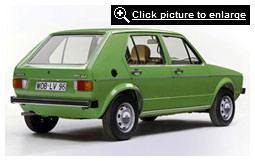 Golf I and II - Nothing to do with it!
Golf I and II - Nothing to do with it! The Golf lent its humble name not to the game where people amble around aimlessly through vast patches of green, hitting white, pint-sized objects with a contraption that appears better utilised as a weapon.
It was deliberately named "Golf-Strom," which is German for the Gulf Stream. Later on, it was simply shortened to "Golf." The Mark I was of course, the water-cooled, front wheel driven hatchback that went into production in 1974. Engines ranged from a puny 1.1-litre to the workhorse 1.6 that produced 68 hp in 1983, just before it was replaced.
It featured independent Macpherson struts in front and a semi-independent, torsion-beam rear. This meant a firmly sprung and better dampened ride with improved cornering performance, which effectively won it Wheels magazine's Car of the Year, 1975.
| |||||
 |
The GTI version followed shortly in 1976, and defined the proverbial "hot-hatch" that many car makers have sought to emulate. It was one of the first cars equipped with fuel injection, and gave the 1,588 cc engine 108 hp.
The Mark II was a bigger, heavier (around 120 kg more) car with a wheelbase that was extended by 75 mm. It was lengthened by 180 mm, widened by 55 mm, and was also taller by 5 mm. Those Giugiaro-styled lines were still there, but appeared rounder.
Volkswagen also introduced the "Synchro," a four-wheel drive that featured viscous couplings and variable torque-split between the front and rear axle. It was utilised in the high performance, "Rallye Golf" - a 5,000 limited production model with a supercharger bolted onto the earlier GTI's 1.8-litre, 8-valver.
Along with the Mark II came several important innovations. An effort to develop both powerful and economical versions of Golf was evident. A further tweak to the GTI meant more peak power - 127 hp with the use of a catalyst and 16-valves. As a polar opposite, the 75 hp, 1.6 GTD "umwelt" turbodiesel slowly became the workhorse of the lot.
Later on, a very special "G60" edition Golf was produced in extremely limited numbers (71 only). With 207 hp and 252 Nm under the bonnet, it was the most powerful of Golfs produced, up until the Mk IV R32. Remarkable, for a car produced in 1989!
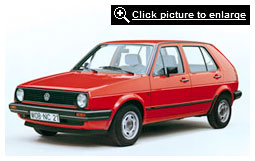 Green roots
Green roots Earlier during that same decade, the Volkswagen-Audi group formulated "E" - which unlike the narcotic, was used as a fuel saving device in large cars such as the Passat and Audi 100. A switch on the steering wheel turned the engine off at the lights, and then fired back up again when first gear was engaged.
A 1981 Golf "E" was produced with 50 hp petrol and 54 hp diesel engines. It was mated to four forward gears. The fourth, or "E" was the overdrive for economical expressway driving. Its A-pillars were redesigned, and it was equipped with narrow tires and a creative display that suggested the best moment to switch gears.
It didn't sound like much during the time, but those important developments gave rise to modern day stop/start systems, as well as the entire BlueMotion lineup in today's Volkswagens.
| |||||
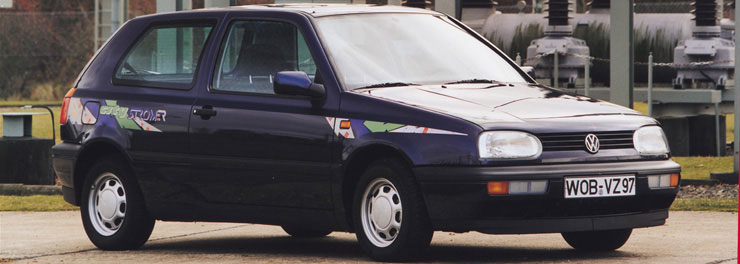 |
Mark III - In pursuit of economy
The third Golf marked a definitive change in the entire lineup. The venerable GTI was replaced with mediocre-performing inline-fours. Even a 2-litre, 16-valver that produced 148 hp in 1993 had problems gaining popularity with the press. Part of this had to do with the car weighing almost 285 kg more, dragging down with it power-to-weight ratio figures and cornering performance.
Volkswagen later answered these disenchanted calls with a new, narrow-angle V6, better known as the VR6 - an arrangement that still exists in today's six-cylinder Volkswagens. The 2.8-litre rendered 172 hp, a far better match to the car's 1285-kilo kerb weight.
The Mark III period was also about pushing the limits of how far one could drive on a litre of fuel. There were many leading developments such as Volkswagen's first full production electric vehicle called the "City Stromer," (pictured at the top of this page) introduced in 1995.
Volkswagen demonstrated what sixteen lead-acid batteries totaling 480 kg could do. 24 hp, 0 to 100 km/h (which was ironically, the fastest speed at which it could travel) in 27 seconds, and a maximum range of 70 km. Rather slow by today's standards, but do consider that it had a brake energy recovery system which Formula One will soon utilise, nearly thirteen years beforehand!
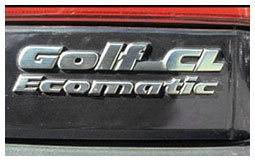 Volkswagen's aforementioned "start-stop" technology was further extemporised, giving rise to the Golf "Ecomatic". This diesel powered unit was mated to a clutchless manual transmission, and was automatically switched off after 1.5 seconds of idling, be it while stopping or coasting. The engine fired up again by means of depressing the accelerator pedal. Unfortunately, it never made the dealerships, citing lack of enthusiasm from the general motoring public.
Volkswagen's aforementioned "start-stop" technology was further extemporised, giving rise to the Golf "Ecomatic". This diesel powered unit was mated to a clutchless manual transmission, and was automatically switched off after 1.5 seconds of idling, be it while stopping or coasting. The engine fired up again by means of depressing the accelerator pedal. Unfortunately, it never made the dealerships, citing lack of enthusiasm from the general motoring public. Finally, the Mark III's roman numerals were dispensed with, and around the same time, Europe's diesel craze started to kick in. This is where Volkswagen's trademark TDI, FSI, direct-injection and common rail technology all started falling into place.
| |||||
 |
Mark 4 - The return to power
In 1997, the fourth Golf marked Volkswagen's ambitious plans to differentiate it's best-seller from lesser, mainstream machines such as SEAT and Škoda, at the same time bridging the gap between these makes and the premium Audi brand.
In effect, the Mark 4 entailed a completely redesigned interior with never-before levels of quality, sophistication and price, i.e., it was more expensive. However, many would agree that it was on par with the previous year's Audi A3 in terms of construction and build quality.
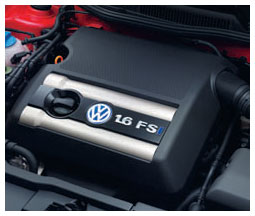 Furthermore, this Golf marked two very important milestones in engine development - FSI petrol and TDI diesel technologies (click on these links for a brief overview). As expected, the 1.6-litre FSI became a very popular choice here in Singapore, as did a very special vertically opposed 5-cylinder called the V5. The torquey 1.9-litre TDI in Europe returned surprisingly high mileage figures of 20.4 km per litre (highway). The year 2000 iteration of TDIs generated an impressive 148 hp at 4,000 rpm and a whopping 320 Nm of torque at just 1,900 rpm - that was more torque than what one would get in today's Golf GTI.
Furthermore, this Golf marked two very important milestones in engine development - FSI petrol and TDI diesel technologies (click on these links for a brief overview). As expected, the 1.6-litre FSI became a very popular choice here in Singapore, as did a very special vertically opposed 5-cylinder called the V5. The torquey 1.9-litre TDI in Europe returned surprisingly high mileage figures of 20.4 km per litre (highway). The year 2000 iteration of TDIs generated an impressive 148 hp at 4,000 rpm and a whopping 320 Nm of torque at just 1,900 rpm - that was more torque than what one would get in today's Golf GTI. The quest for power and torque wasn't over yet, with further development of the FSI engine. During that same year, the Volkswagen-Audi group introduced the 20-valve, 1.8-litre turbocharged FSI used in the Golf GTI. It quickly proved to be a popular tuning base. Even in stock form, it already put out 148 hp at 5,700 rpm and 210 Nm at a low, low 1,750 rpm.
The VR6 engine from the Mk III Golf wasn't spared either - it spawned the first variant of R32, which first went on sale in Europe around the turn of 2003. The 2.8-litre was bored out and reworked to yield 3.2-litres. Volkswagen claimed 241 bhp and 320 Nm of torque. It also had Volkswagen's 6-speed manual linked to the patented 4-motion all-wheel drive that came with Haldex couplings - similar to that of the Audi RS4.
| |||||
 |
Five. Power and efficiency
Unveiled at the Frankfurt Motor Show in October of 2003, the fifth Golf was redesigned yet again to be a bigger, and more refined. The 1.6 and 2.0-litre FSI engines were a carry-over, and didn't garner much interest.
Therefore, it wasn't until the arrival of the GTI and new R32 that got the world excited once again. Its multi-linked rear was perceived to be a marked improvement over that of its benchmark rival with a similar setup, the Ford Focus.
Then, the Golf GT made history in 2005 with the 1.4-litre turbo and supercharged TSI engine. Needless to say, it yielded as much torque, if not more, than an atmospheric 2.4-litre V6. Extremely efficient (10-14 km/l) in real world testing conditions.
It has also formed the basis of Volkswagen's new range of TSI, forced-induction range of engines. Such an example would be the 1.4-litre turbocharged (only) Golf 1.4 TSI mated to the new 7-speed DSG. It produced a 14-17 km/l average rate of fuel consumption, winning the 2008 Golden Drop of Oil and Yellow Angel Awards for Volkswagen's Latest High-End Technologies
 Overseas, Vee-dub has materialized a new, Euro-5 friendly Golf BlueMotion that promises to equal that of the Polo BlueMotion sold in Singapore. With 3.8 liters per 100 kilometers, breaking the barrier of 4.0 l/100 km for the first time in the Golf market segment, while CO2 emissions are kept to 99 g/km - the same as the Polo.
Overseas, Vee-dub has materialized a new, Euro-5 friendly Golf BlueMotion that promises to equal that of the Polo BlueMotion sold in Singapore. With 3.8 liters per 100 kilometers, breaking the barrier of 4.0 l/100 km for the first time in the Golf market segment, while CO2 emissions are kept to 99 g/km - the same as the Polo. Powered by a new common rail 1.6-litre turbo-diesel that delivers 104 bhp and 250 Nm at 2,000 rpm, it still does 100 km/h from rest in 11.3 seconds and 190 km/h for top whack.
And all of this is amazing, because Volkswagen really has gone the way of their own name and built very competent cars that anyone and everyone might need. They aren't very fancy, but they are something special built by people who know what other people need, not want - practicality, functionality, efficiency and a good spread of power and torque that will put a smile on anyone's face.
This was despite the fact it was, and still is rather expensive and slow to build. Welding and bolting together everything might take as long as 50-hours per car.
Many have long speculated that the Mark 5's replacement would arrive during the 2008 period, which is a good two years earlier than originally scheduled. And it has. Based on the venerable platform of the Mark 5, the Volkswagen Golf Mark 6 promises to be all of that, and more.
| |||||
Remember the original Beetle? It was all the rage during the sixties. Ferdinand Porsche's iconic creation proved to be a huge hit. That is, until the novelty wore off amidst financial difficulties during the oil-crisis at the time. Front-engined, rear driven Japanese creations like the Toyota Corolla were quickly starting to gain popularity worldwide.
Therefore, replacing the Beetle was important for VW's survival. They turned to a small, Ingolstadt based company from the Auto Union that they had acquired in 1964 from Daimler-Benz - none other than Audi.
It seemed that Audi, at the time, had been toying around with the idea of a water-cooled, front-engined, front-wheel driven concept much like the Citroen Traction (1934), Renault 4 and Austin Mini. By means of eliminating the rear transaxle and driveline altogether, weight would be saved, and there would be gains in both space and performance. Volkswagen adopted this novel idea in 1969, improved on it and made their mark with, transverse, front engined, front driven layout that stays true till this day.
 Golf I and II - Nothing to do with it!
Golf I and II - Nothing to do with it! The Golf lent its humble name not to the game where people amble around aimlessly through vast patches of green, hitting white, pint-sized objects with a contraption that appears better utilised as a weapon.
It was deliberately named "Golf-Strom," which is German for the Gulf Stream. Later on, it was simply shortened to "Golf." The Mark I was of course, the water-cooled, front wheel driven hatchback that went into production in 1974. Engines ranged from a puny 1.1-litre to the workhorse 1.6 that produced 68 hp in 1983, just before it was replaced.
It featured independent Macpherson struts in front and a semi-independent, torsion-beam rear. This meant a firmly sprung and better dampened ride with improved cornering performance, which effectively won it Wheels magazine's Car of the Year, 1975.
| |||||
 |
The GTI version followed shortly in 1976, and defined the proverbial "hot-hatch" that many car makers have sought to emulate. It was one of the first cars equipped with fuel injection, and gave the 1,588 cc engine 108 hp.
The Mark II was a bigger, heavier (around 120 kg more) car with a wheelbase that was extended by 75 mm. It was lengthened by 180 mm, widened by 55 mm, and was also taller by 5 mm. Those Giugiaro-styled lines were still there, but appeared rounder.
Volkswagen also introduced the "Synchro," a four-wheel drive that featured viscous couplings and variable torque-split between the front and rear axle. It was utilised in the high performance, "Rallye Golf" - a 5,000 limited production model with a supercharger bolted onto the earlier GTI's 1.8-litre, 8-valver.
Along with the Mark II came several important innovations. An effort to develop both powerful and economical versions of Golf was evident. A further tweak to the GTI meant more peak power - 127 hp with the use of a catalyst and 16-valves. As a polar opposite, the 75 hp, 1.6 GTD "umwelt" turbodiesel slowly became the workhorse of the lot.
Later on, a very special "G60" edition Golf was produced in extremely limited numbers (71 only). With 207 hp and 252 Nm under the bonnet, it was the most powerful of Golfs produced, up until the Mk IV R32. Remarkable, for a car produced in 1989!
 Green roots
Green roots Earlier during that same decade, the Volkswagen-Audi group formulated "E" - which unlike the narcotic, was used as a fuel saving device in large cars such as the Passat and Audi 100. A switch on the steering wheel turned the engine off at the lights, and then fired back up again when first gear was engaged.
A 1981 Golf "E" was produced with 50 hp petrol and 54 hp diesel engines. It was mated to four forward gears. The fourth, or "E" was the overdrive for economical expressway driving. Its A-pillars were redesigned, and it was equipped with narrow tires and a creative display that suggested the best moment to switch gears.
It didn't sound like much during the time, but those important developments gave rise to modern day stop/start systems, as well as the entire BlueMotion lineup in today's Volkswagens.
| |||||
 |
Mark III - In pursuit of economy
The third Golf marked a definitive change in the entire lineup. The venerable GTI was replaced with mediocre-performing inline-fours. Even a 2-litre, 16-valver that produced 148 hp in 1993 had problems gaining popularity with the press. Part of this had to do with the car weighing almost 285 kg more, dragging down with it power-to-weight ratio figures and cornering performance.
Volkswagen later answered these disenchanted calls with a new, narrow-angle V6, better known as the VR6 - an arrangement that still exists in today's six-cylinder Volkswagens. The 2.8-litre rendered 172 hp, a far better match to the car's 1285-kilo kerb weight.
The Mark III period was also about pushing the limits of how far one could drive on a litre of fuel. There were many leading developments such as Volkswagen's first full production electric vehicle called the "City Stromer," (pictured at the top of this page) introduced in 1995.
Volkswagen demonstrated what sixteen lead-acid batteries totaling 480 kg could do. 24 hp, 0 to 100 km/h (which was ironically, the fastest speed at which it could travel) in 27 seconds, and a maximum range of 70 km. Rather slow by today's standards, but do consider that it had a brake energy recovery system which Formula One will soon utilise, nearly thirteen years beforehand!
 Volkswagen's aforementioned "start-stop" technology was further extemporised, giving rise to the Golf "Ecomatic". This diesel powered unit was mated to a clutchless manual transmission, and was automatically switched off after 1.5 seconds of idling, be it while stopping or coasting. The engine fired up again by means of depressing the accelerator pedal. Unfortunately, it never made the dealerships, citing lack of enthusiasm from the general motoring public.
Volkswagen's aforementioned "start-stop" technology was further extemporised, giving rise to the Golf "Ecomatic". This diesel powered unit was mated to a clutchless manual transmission, and was automatically switched off after 1.5 seconds of idling, be it while stopping or coasting. The engine fired up again by means of depressing the accelerator pedal. Unfortunately, it never made the dealerships, citing lack of enthusiasm from the general motoring public. Finally, the Mark III's roman numerals were dispensed with, and around the same time, Europe's diesel craze started to kick in. This is where Volkswagen's trademark TDI, FSI, direct-injection and common rail technology all started falling into place.
| |||||
 |
Mark 4 - The return to power
In 1997, the fourth Golf marked Volkswagen's ambitious plans to differentiate it's best-seller from lesser, mainstream machines such as SEAT and Škoda, at the same time bridging the gap between these makes and the premium Audi brand.
In effect, the Mark 4 entailed a completely redesigned interior with never-before levels of quality, sophistication and price, i.e., it was more expensive. However, many would agree that it was on par with the previous year's Audi A3 in terms of construction and build quality.
 Furthermore, this Golf marked two very important milestones in engine development - FSI petrol and TDI diesel technologies (click on these links for a brief overview). As expected, the 1.6-litre FSI became a very popular choice here in Singapore, as did a very special vertically opposed 5-cylinder called the V5. The torquey 1.9-litre TDI in Europe returned surprisingly high mileage figures of 20.4 km per litre (highway). The year 2000 iteration of TDIs generated an impressive 148 hp at 4,000 rpm and a whopping 320 Nm of torque at just 1,900 rpm - that was more torque than what one would get in today's Golf GTI.
Furthermore, this Golf marked two very important milestones in engine development - FSI petrol and TDI diesel technologies (click on these links for a brief overview). As expected, the 1.6-litre FSI became a very popular choice here in Singapore, as did a very special vertically opposed 5-cylinder called the V5. The torquey 1.9-litre TDI in Europe returned surprisingly high mileage figures of 20.4 km per litre (highway). The year 2000 iteration of TDIs generated an impressive 148 hp at 4,000 rpm and a whopping 320 Nm of torque at just 1,900 rpm - that was more torque than what one would get in today's Golf GTI. The quest for power and torque wasn't over yet, with further development of the FSI engine. During that same year, the Volkswagen-Audi group introduced the 20-valve, 1.8-litre turbocharged FSI used in the Golf GTI. It quickly proved to be a popular tuning base. Even in stock form, it already put out 148 hp at 5,700 rpm and 210 Nm at a low, low 1,750 rpm.
The VR6 engine from the Mk III Golf wasn't spared either - it spawned the first variant of R32, which first went on sale in Europe around the turn of 2003. The 2.8-litre was bored out and reworked to yield 3.2-litres. Volkswagen claimed 241 bhp and 320 Nm of torque. It also had Volkswagen's 6-speed manual linked to the patented 4-motion all-wheel drive that came with Haldex couplings - similar to that of the Audi RS4.
| |||||
 |
Five. Power and efficiency
Unveiled at the Frankfurt Motor Show in October of 2003, the fifth Golf was redesigned yet again to be a bigger, and more refined. The 1.6 and 2.0-litre FSI engines were a carry-over, and didn't garner much interest.
Therefore, it wasn't until the arrival of the GTI and new R32 that got the world excited once again. Its multi-linked rear was perceived to be a marked improvement over that of its benchmark rival with a similar setup, the Ford Focus.
Then, the Golf GT made history in 2005 with the 1.4-litre turbo and supercharged TSI engine. Needless to say, it yielded as much torque, if not more, than an atmospheric 2.4-litre V6. Extremely efficient (10-14 km/l) in real world testing conditions.
It has also formed the basis of Volkswagen's new range of TSI, forced-induction range of engines. Such an example would be the 1.4-litre turbocharged (only) Golf 1.4 TSI mated to the new 7-speed DSG. It produced a 14-17 km/l average rate of fuel consumption, winning the 2008 Golden Drop of Oil and Yellow Angel Awards for Volkswagen's Latest High-End Technologies
 Overseas, Vee-dub has materialized a new, Euro-5 friendly Golf BlueMotion that promises to equal that of the Polo BlueMotion sold in Singapore. With 3.8 liters per 100 kilometers, breaking the barrier of 4.0 l/100 km for the first time in the Golf market segment, while CO2 emissions are kept to 99 g/km - the same as the Polo.
Overseas, Vee-dub has materialized a new, Euro-5 friendly Golf BlueMotion that promises to equal that of the Polo BlueMotion sold in Singapore. With 3.8 liters per 100 kilometers, breaking the barrier of 4.0 l/100 km for the first time in the Golf market segment, while CO2 emissions are kept to 99 g/km - the same as the Polo. Powered by a new common rail 1.6-litre turbo-diesel that delivers 104 bhp and 250 Nm at 2,000 rpm, it still does 100 km/h from rest in 11.3 seconds and 190 km/h for top whack.
And all of this is amazing, because Volkswagen really has gone the way of their own name and built very competent cars that anyone and everyone might need. They aren't very fancy, but they are something special built by people who know what other people need, not want - practicality, functionality, efficiency and a good spread of power and torque that will put a smile on anyone's face.
This was despite the fact it was, and still is rather expensive and slow to build. Welding and bolting together everything might take as long as 50-hours per car.
Many have long speculated that the Mark 5's replacement would arrive during the 2008 period, which is a good two years earlier than originally scheduled. And it has. Based on the venerable platform of the Mark 5, the Volkswagen Golf Mark 6 promises to be all of that, and more.
| |||||
Thank You For Your Subscription.

































